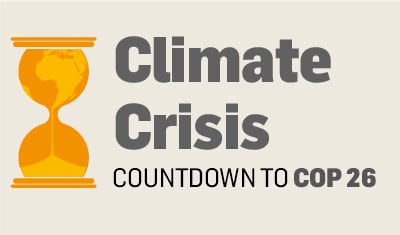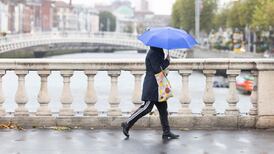Exceptionally low levels of wind in July meant it supplied only 12 per cent of Irish electricity demand, compared to 31 per cent in 2020. Natural gas had to fill the gap “even in summer”, says Prof Brian Ó Gallachóir.
Unusual weather patterns in Ireland and throughout much of northwestern Europe have created havoc with renewable energy supplies so far this year, contributing to a turbulent period for energy prices.
Low wind conditions – a record low during the summer – and cooler temperatures for the most part from early spring and persisting right through to summer, significantly reduced wind energy capacity.
This fed into a crisis whereby drastic gas shortages across Europe have triggered soaring gas prices, with electricity prices soon to follow. For many, it will be a long winter.
Ireland experienced the coldest April since 2003, explains Ó Gallachóir, an energy specialist with MaREI research centre in UCC, which meant gas reserves were not built up in late Spring, as usually happens.
And it highlights our volatility because of the State’s limited options. In July, 54 per cent of electricity came from natural gas, higher than the UK, with 41 per cent.

“The UK has nuclear power and biomass power, which both provide an additional cushion against gas price fluctuations at times when wind speeds are low,” he points out.
That would be fine normally but Ireland’s two main gas-fired power stations were out of action due to inability to fully service and maintain them during Covid-19. That gap is due to be rectified in coming weeks.
Other factors elsewhere exacerbated matters including a surge in gas and electricity demand post Covid-19 and a warm summer in Asia requiring increased air conditioning.
Scaling up reneweables
Europe desperately needs the politically controversial Nord Stream 2 pipeline from Russia, which is awaiting approval by German regulators. Some analysts believe this explains the squeeze on supplies. Others suggest it makes the case for scaling up renewables.
The collapse of the power system in Texas due to a winter storm and other weather-related risks (notably a cold snap when wind does not blow and electricity demand shoots up) had prompted MaREI researchers to evaluate the resilience of the Irish supply system earlier this year.
This shortfall of wind (the solar equivalent is cloudy skies) is known as renewable intermittency problem, forcing the use of battery-stored energy, or other fuels.
That was exactly the picture facing MaREI researchers when evaluating conditions in January. Their study showed natural gas is the key fuel needed to bridge renewable gaps: “It’s not the enemy of wind,”Ó Gallachóir says.
The unusually low wind patterns continue. So far this month, there have been no gales whatsoever, while four weather stations have reported their lowest mean wind speed on record.
"In September the jet stream was to the north of Ireland. It's normally over the country, when you get more wind," confirms Met Éireann climatologist Paul Moore.
For the summer, 10 stations had their lowest wind speeds on record due to a lot of “blocking highs”; slow moving or stationary areas of high pressure.
While recent patterns may be due to normal weather variation, there is evidence “windiness reduces slightly, by 1 per cent” due to global warming, though individual storm systems have potential to be stronger, Moore notes.
February had been a bumper month for those with wind turbines, but then all changed, says Noel Cunniffe chief executive of Wind Energy Ireland.
From January to August wind provided 29.8 per cent of Ireland’s electricity. For the same period in 2020 it was at 37.2 per cent, the highest ever share ever: “It was challenging because we don’t have any offshore wind,” he adds.
On September 22nd, the average capacity available offshore in Europe was almost twice as high as onshore. As it happens onshore wind in Ireland was strong that day at 43.5 per cent “but it shows just how much stronger we would be if we had offshore wind energy as well”, Cunniffe believes. Offshore turbines are larger and generate more power at lower wind speeds.
Above all, this year’s conditions underline the case for diversification, he says, not just offshore but solar, too – the first tranche of solar projects are due to be connected to the grid next year.
With Minister for Climate Eamon Ryan admitting current difficulties may persist for several winters to come, Cunniffe says long-duration battery storage is needed and urgently.
That would mean batteries with capacity to store power for four hours rather than 30 minutes at present, which could be critical to meeting evening peak demand, he says.
Ireland can be energy independent, despite the variabilities, says Cunniffe: “We can build our own renewable energy industry with offshore wind at its heart,” he adds.
Because battery storage is expensive, Europe relies on power interconnectors, moving renewable energy around to try and balance out supply. But low renewable supplies combined with low gas volumes is temporarily forcing the re-carbonisation of the European power system, and doing so at a high cost. Ireland is being forced to bring Moneypoint coal-fired power station back into the mix.
What about Germany?
The wind will pick up again but others suggest a more fundamental shift. Increased reliance on renewable energy, higher carbon prices, weather disruptions, and geopolitical wrangling with Russia could mean price volatility for years to come.
The oil and gas industry argues this means that fossil fuels cannot be relegated, but the climate crisis and rising carbon prices dictate otherwise, though managing intermittency will be an ongoing issue.
Germany, for instance, is phasing out both nuclear and coal plants, which will make gas supplies an even more critical ingredient in the fuel mix to cushion market swings.
With wind and solar now a lot cheaper than coal and gas, the Electrification Alliance, representing big players in Europe’s electricity sector, this week called on the EU to remove barriers to developing renewables. The benefits of wind and solar must be maximised: “The more we have of them, along with efficient grids, energy storage and other forms of flexibility, the lower our energy bills.”
The challenges facing supplies are often underestimated, Ó Gallachóir believes, because people usually never have to fear that the lights will go out, even for an hour. Security is taken for granted.
Robust systems will be needed to ensure public confidence continues, and that we have a system capable of keeping the lights on even when the wind does not blow.












